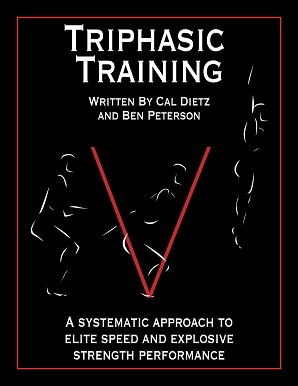About a month ago, I can't even remember what I was searching for, but came across a review for Triphasic Training by Cal Dietz. I hate to admit it, but I had never even heard of him before. After about 20 minutes of reading the reviews and looking into some articles published to kind of hype up the book I ended up buying it. It was a Sunday night, the book was delivered to my inbox by Monday afternoon and I finished it by Wednesday It was like seeing a great movie, after I finished the last page of text and looked over all the sample programs and different modifications for the training splits, I just sat there.. And then felt like watching it again. Instead of doing that though, I just went back through all the charts and made my own copies of them on Excel and pinned them up beside my computer. This was going to take some experimenting.
Basically, the premise of this book rings back to a heading in Supertraining and that is "All athletic movement is triphasic." That's a pretty strong statement.
The shape of the "V" on the front of the book makes more sense after you read it and grasp the foundational concepts. As I mentioned in one of my articles about speed training there was a eccentric, amortization, and concentric phase with each stride. On a more loosely applied but still concrete basis, this is true of everything we do in sport, throwing, running, cutting, jumping etc.
Anyone who has read reviews or articles on this concept has seen this picture. The sharper blue "V" is a visual representation of a more powerful, explosive and neurally efficient athlete. In this case, a shot putter performing an explosive rep on the bench press. Basically, what you're seeing is someone who can take a sharp eccentric action and spin it around into a powerful QUICK concentric action. This guy beat the pants off the red line guy on the actual throws.
Dietz puts a powerful new spin on block periodization and divides the training schedule into blocks based on different parts of movement (Eccentric, Isometric, Concentric.) He Follows that up with a standard (what everyone else does) "reactive" block and then where appropriate tacks on a fifth block of what he calls the "Antagonistically Facilitated Speed Strength Method" which - in as few words as possible - uses timed sets, drop-offs, and other bio-feedback methods.
Honestly, after reading this book, I felt like I'd read 2 books, actually 3. Maybe 4, I don't know. All I know is that this stuff started making a WHOLE lot more sense to me. What in the world was I doing before?! About a week after reading this, I based my own programming on the same model and started experimenting on myself. I loved the results I was feeling. I have also applied the same principles to 4 or 5 athletes whom I work with on a regular basis to prepare them for college, and this has been a very rewarding experience for all of us. If you haven't checked out this book and are serious about getting stronger, faster, and more powerful, you're kidding yourself. Unless you already know everything, which let's be serious - If you think you know everything, you're an idiot.


No comments:
Post a Comment
Give us your thoughts!